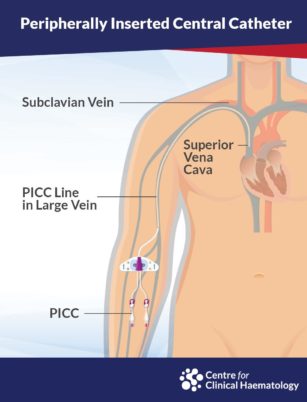PICC Line
PICC
What is a Peripherally Inserted Central Catheter (PICC)?
It is a long, thin, flexible tube (catheter) that is inserted into one of the large veins in the upper arm, just above the elbow. Guided by ultrasound, it is threaded along the vein into a place near the heart.
This procedure is performed under local anesthetic. The PICC can be inserted into either arm depending on your preference, medical condition and history. After insertion, you can go home with the PICC, and it can be left in place for weeks or months until you complete your treatment.

What are the benefits of having a PICC?
It is recommended for long-term treatments that require:
- Frequent administration of intravenous (IV) therapies such as chemotherapy.
- Frequent taking of blood samples.
- Direct administration of medicines into the central vein.
The benefits of having a PICC in place include:
- Reducing the discomfort, pain and damage to the veins caused by these long-term treatments.
You will not need to be injected by needles every time you have treatment or when blood samples are required.
What are the risks of having a PICC?
While a PICC is generally very safe, there are still potential risks and complications.
Risks during insertion:
- Discomfort or pain caused by the local anaesthetic.
- Blood infection.
- Bleeding due to accidental puncturing of an artery.
- Pain caused by accidental touching of a nerve by the needle.
Complications after insertion:
- Infection:Some patients may develop an infection which can be treated with antibiotics. In severe cases, the PICC will have to be removed.
- Blood clot (thrombosis):In rare cases (less than 3 in 100), a patient with PICC having chemotherapy treatment can develop thrombosis. This can be treated with medication to clear the clotting.
Blockage (occlusion): This is usually caused by blood in the tube when the tube is not adequately flushed through after use or when the tube is out of position.
Are there any alternatives to PICC?
The doctor will determine whether a PICC would be the best device for you based on your treatment, medical condition and history. A Port-a-Cath or Hickman Line are alternative options.
How is the PICC inserted?
You will be asked to lie on a bed, on your back with your arms outstretched and well-supported. The insertion area on your arm will then be cleaned with antiseptic fluid to ensure that it is sterile.
A local anaesthetic will be injected into your arm to make the area numb before a small incision is made in the skin of the arm at the insertion point. The PICC will be threaded gently into the vein and passed along its course, guided by ultrasound, to be placed near the heart. You should not feel any pain except for a bit of discomfort.
Once the PICC is in position, a skin fixation device and dressing will be placed at insertion point to secure the catheter.
How do I care for my PICC?
To avoid infection, you need to:
- Keep the dressing dry and clean: Our doctors and nurses will advise you on how to protect the dressing, such as keeping it dry while having a shower/bath.
- Change the dressing regularly: Our nurses will help you to change your dressing. The frequency of this is determined by the type of dressing. If the dressing is wet, or your skin develops any redness, the dressing should be changed immediately.
Our dedicated nurses will provide you with any assistance to help you care for your PICC.
How is the PICC removed?
After you have completed your treatment and no longer need the PICC, an appointment will be made to remove it.
Disclaimer: All rights reserved to the owner of the content. We are using it just for educational purpose.

